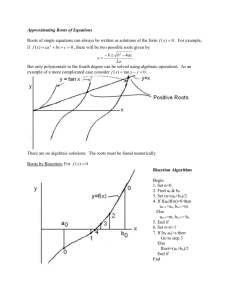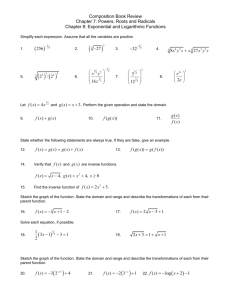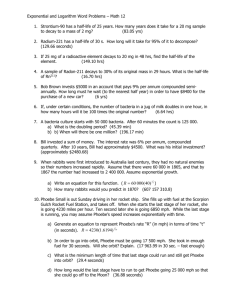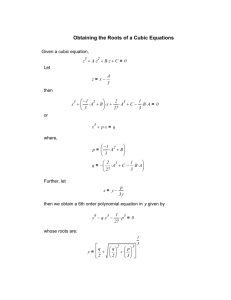Phoebe Floats! The problem - Mathematical Association of America
advertisement
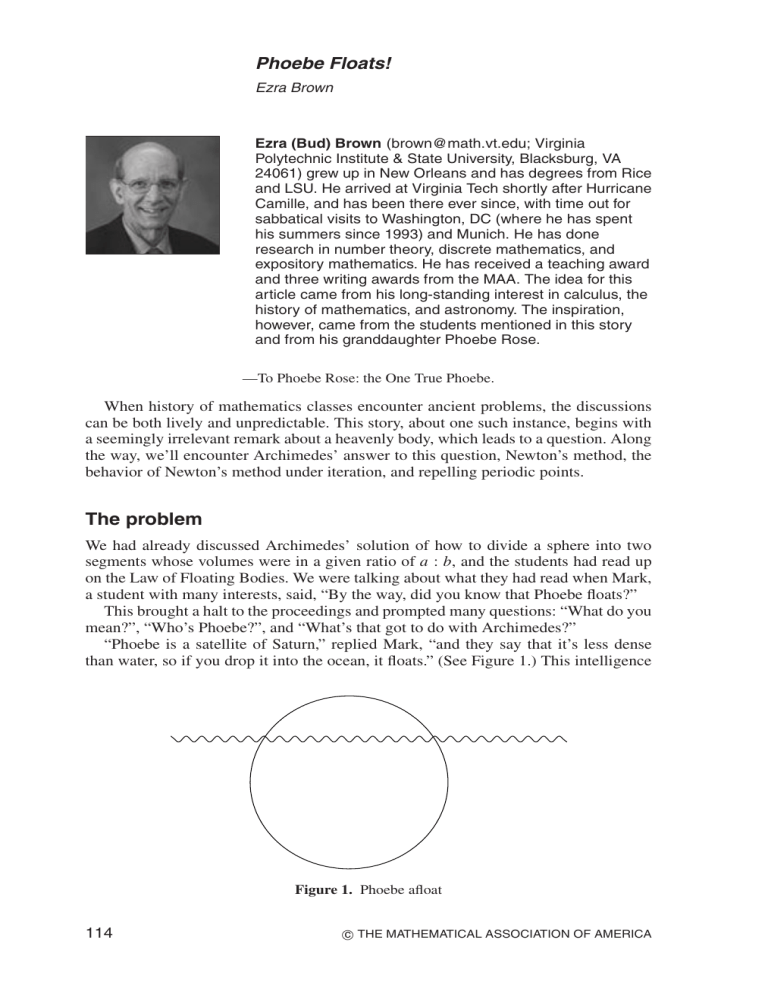
Phoebe Floats!
Ezra Brown
Ezra (Bud) Brown (brown@math.vt.edu; Virginia
Polytechnic Institute & State University, Blacksburg, VA
24061) grew up in New Orleans and has degrees from Rice
and LSU. He arrived at Virginia Tech shortly after Hurricane
Camille, and has been there ever since, with time out for
sabbatical visits to Washington, DC (where he has spent
his summers since 1993) and Munich. He has done
research in number theory, discrete mathematics, and
expository mathematics. He has received a teaching award
and three writing awards from the MAA. The idea for this
article came from his long-standing interest in calculus, the
history of mathematics, and astronomy. The inspiration,
however, came from the students mentioned in this story
and from his granddaughter Phoebe Rose.
—To Phoebe Rose: the One True Phoebe.
When history of mathematics classes encounter ancient problems, the discussions
can be both lively and unpredictable. This story, about one such instance, begins with
a seemingly irrelevant remark about a heavenly body, which leads to a question. Along
the way, we’ll encounter Archimedes’ answer to this question, Newton’s method, the
behavior of Newton’s method under iteration, and repelling periodic points.
The problem
We had already discussed Archimedes’ solution of how to divide a sphere into two
segments whose volumes were in a given ratio of a : b, and the students had read up
on the Law of Floating Bodies. We were talking about what they had read when Mark,
a student with many interests, said, “By the way, did you know that Phoebe floats?”
This brought a halt to the proceedings and prompted many questions: “What do you
mean?”, “Who’s Phoebe?”, and “What’s that got to do with Archimedes?”
“Phoebe is a satellite of Saturn,” replied Mark, “and they say that it’s less dense
than water, so if you drop it into the ocean, it floats.” (See Figure 1.) This intelligence
Figure 1. Phoebe afloat
114
c THE MATHEMATICAL ASSOCIATION OF AMERICA
proved to be from a website [1], which also gave Phoebe’s diameter as 220 kilometers
and its mass as 4.0 × 1018 kilograms. A few seconds later: “That puts the density at
about 7/10.”
“I think this does have something to do with Archimedes,” said Carla. “The book
says that if you know the density of a floating ball, you can figure out how far down
the bottom of the ball sinks below the surface. So, we can . . .”
“. . . we can see how far Phoebe would sink by knowing her density and comparing
the volume below the surface to the volume above the surface,” Jason broke in, “and
then . . .”
“. . . calculate the volume in terms of the unknown depth, using integrals,” added
Nick, “and . . .”
“. . . back-solve for the depth,” finished Karen triumphantly.
“Great!” I said. “Go home, solve the problem, write it up, and present it to the class
next time.” So they did.
In this article, we’ll see how the students solved the problem. We will also examine a
particularly interesting wrinkle to the problem (see [4]), involving the chaotic behavior
of Newton’s method applied to a cubic polynomial.
Solving the original problem
To standardize the problem, we’ll work with a ball of radius 1 and Phoebe’s density 7/10, then scale up to find the results for Phoebe. We also assume that the density
of water is 1. Here is a statement of the problem.
A ball of radius 1 and density 7/10 is placed in a body of water. How far down does
the ball sink below the surface?
Archimedes’ Law of Floating Bodies states that a body immersed in a fluid displaces an amount of fluid equal in weight to the weight of the body, provided the body
is less dense than the fluid. In plain English, a floating object displaces its weight. An
object of density δ and volume V cubic units weighs exactly as much as an amount
of water of volume δ · V cubic units. That means that our ball sinks until exactly δ
percent of its volume is underwater.
We now translate the problem into mathematics. We represent the ball by its crosssection through the poles, namely a circle of radius 1 with its center at the origin. The
waterline is a horizontal line, and the depth underwater is a length we’ll call r . In the
case of density 1/2, half the ball is submerged and the depth equals 1, the radius. Since
our density is greater than 1/2, it’s clear that more than half of Phoebe is submerged,
and so r is between 1 and 2.
We place the ball so that its south pole is at (0, −1) and so that the waterline intersects the y-axis at the point (0, −1 + r ); see Figure 2. The volume of a ball of radius 1
is equal to 4π/3, so our mission is to find that value of r so that the segment of the ball
between y = −1 and y = −1 + r has volume (4π/3)(7/10), or 70% of the volume of
the ball.
We may now set up an integral to find the volume of the segment. Since the equation
2
2
of the unit
circle is x + y = 1, a slice of the segment through yk of thickness yk has
radius 1 − yk2 . The volume Vk of the slice is then π(1 − yk2 ) yk . Hence, the volume
VS of the segment is approximated by nk=1 π(1 − xk2 ) xk , and so
7 4π
·
= VS =
10 3
−1+r
−1
π(1 − y 2 ) dy
VOL. 36, NO. 2, MARCH 2005 THE COLLEGE MATHEMATICS JOURNAL
115
1
∆yk
–1 + r
–1
1
–1
Figure 2. Phoebe with calculus
−1+r
y3
=π y−
,
3 −1
and a little algebra shows that
28π
r3
2
=π r −
.
30
3
= 0. More generally, if the ball has density δ then r
Thus, r satisfies r 3 − 3r 2 + 14
5
3
2
satisfies r − 3r + 4δ = 0.
Nick, who kept up with the latest events in the scientific world, asked, “Is this
how Archimedes solved the problem? I once thought that he didn’t have integrals, but
aren’t the people who are studying his Method saying that he came awfully close to
integrals?” I pounced on this teachable moment: “Good question, why don’t some of
you read about what’s in the Method and let the rest of us know.”
What the students learned was that Archimedes’ solution to this problem was extremely clever. First, he observed that a spherical sector (think of an ice-cream cone
with vertex at the center of the sphere) is composed of a spherical segment sitting on
top of a right circular cone. Then, he used Eudoxus’s Method of Exhaustion to prove
that the volume of a spherical sector is equal to one-third of the product of its radius
and the area of its spherical curved surface. Since he knew how to find the volume of a
right circular cone, all he had to do was subtract volumes, and what remained was the
volume of his spherical segment. In particular, he found the formula for the volume
of a sphere by pointing out that the entire sphere is also an ice-cream cone. See [5,
pp. 62–66] for Archimedes’ original proof, and [7, Chapter 10] for an illuminating
discussion.
In their own solutions, the students did the integration and arrived at the last
equation without much difficulty. They were surprised by the appearance of a cubic
polynomial, but most of them found the roots of r 3 − 3r 2 + 14/5 using a calculator
or a computer algebra system. However, Matt, our chief skeptic, had a good question:
“Wait a minute, r 3 − 3r 2 + 4δ is a cubic polynomial. Isn’t there a cubic formula?”
“Yes, there is,” I said. “It was found in the sixteenth century, and the tale of its
116
c THE MATHEMATICAL ASSOCIATION OF AMERICA
discovery is full of intrigue, treachery, murder, and—but that’s a whole nother story.”
(See [2, pp. 291–309] for further details.)
But Matt would not be put off. “Don’t start with your digressions . . . just give us
the word on the cubic formula.” So I did.
The Cardano–Tartaglia formula, as it’s called, is an algebraic expression for the
three roots of an arbitrary cubic polynomial. The formula gives the three roots of
r 3 − 3r 2 + 14/5 as
r j = 1 + 2 cos 2 jπ + arccos(−2/5) /3 , for j = 0, 1, 2.
(1)
At this point, Karen pointed out that it is not at all obvious which of the three
values of r j from equation (1) gives us “the answer.” “And another thing,” she added.
“What would we have done without the cubic formula? If we had to find the roots of a
seventh-degree polynomial, we’d need a computer, so how do computers find roots of
functions?”
This was an excellent question, so we pushed on. One of the root-finding strategies
a computer algebra system (or CAS) employs is popularly known as Newton’s method,
so let’s talk about Newton’s method.
Cubic equations, CAS, and Newton’s method
From the graph of y = r 3 − 3r 2 + 14/5, we see that there is a root in each of the intervals (−1, 0), (1, 2), and (2, 3). Our friendly CAS comes to the rescue and discloses
that, to six decimal places, the three roots are −0.852523, 1.273485, and 2.579038,
and this seems to agree with the graph in Figure 3. These three roots correspond to the
solutions in equation (1) for j = 1, 2, and 0, respectively. Problem solved—or is it?
2
y = r3 – 3r2 + 14/5
1
–1
1
2
3
–1
Figure 3. The roots of r 3 − 3r 2 + 14/5
You see, the physical problem has only one solution: if you throw a body, er, a moon
of Saturn, into water, it sinks to only one level. Which of these roots is “the answer”?
To figure that out, we go back to our original formulation. The ball had radius 1 and the
depth r was between 1 and 2. Thus, the answer to our problem is r2 , or 1.273485 to six
places. Phoebe’s radius is about 110 km, so she sinks to a depth of about 140.083 km.
This means that when viewed while in the water, Phoebe looks like a spherical segment
about 80 km high (about 49 miles) at its highest point. Problem solved; we’re done.
Or are we?
Well, not quite. How, for example, did the CAS find those three roots? Surely we
don’t believe the answers merely because they were found by a computer?
VOL. 36, NO. 2, MARCH 2005 THE COLLEGE MATHEMATICS JOURNAL
117
In fact, we are on solid ground here. The typical CAS package uses a number of
strategies for finding roots, but mainly Newton’s Method.
Newton began with some convenient approximation x0 to a root of a given differentiable function f . He then noticed that under favorable conditions, x1 = x0 − ff (x(x00))
is closer than x0 to the root in question.
So he defined a sequence of numbers {xn } by putting xn+1 = xn − ff (x(xnn)) . Now under
those favorable conditions, which occur for example in Figure 4, the sequence {xn }
converges to a root of f . (See [2, pp. 58–66] for further details.)
x3
x2
x1
Figure 4. Newton’s Method
To find how much of Phoebe rises up out of the ocean, we want to use Newton’s method to approximate the roots of f (x) = x 3 − 3x 2 + 14/5. Since f (x) =
3x 2 − 6x, our “Newton function” for this problem is
N (x) = x −
x 3 − 3x 2 + 14/5
2x 3 − 3x 2 − 14/5
f (x)
=
x
−
=
.
f (x)
3x 2 − 6x
3x 2 − 6x
To begin, we choose some convenient value for x0 ; the only restriction is that it can’t
be either 0 or 2 (why so?). We then evaluate N (x0 ) and call that x1 ; we evaluate N (x1 )
and call that x2 , and so forth. But if a function has more than one root, then different
starting values for x0 might converge to different roots, as we see in Table 1 (values
are calculated to 10 places):
Table 1. N (xi ) for x0 = −1, 1 and 3
i
xi
xi
xi
0
1
2
3
4
5
6
7
8
−3
−1.8637735810
−1.2145647824
−0.9287789619
−0.8651469860
−0.8620310100
−0.8620236739
−0.8620236739
−0.8620236739
1
1.2899370483
1.2988070666
1.2988323699
1.2988323701
1.2988323701
1.2988323701
1.2988323701
1.2988323701
5
3.8251153078
3.1116597461
2.7309306013
2.5868016405
2.5637711504
2.5631916674
2.5631913037
2.5631913037
It is clear that what we are doing is iterating the function N . If all goes well, the
iterates will converge to a root. It doesn’t always go well, however; but for f (x) =
x 3 − 3x 2 + 14/5 it appears that N behaves itself and everything works out just fine.
At this point, I threw the class a curve.
118
c THE MATHEMATICAL ASSOCIATION OF AMERICA
Sensitive dependence on initial conditions
“Here are three starting values for Newton’s method,” I told them, “that differ only by
1 or 2 in the fifth decimal place: 1.86693, 1.86695, and 1.86696. Any guesses as to
what will happen when you run the algorithm on them?” Most of the class seemed to
think that such a small difference would not affect the outcome.
Carla, however, was suspicious. “What’s so special about those numbers? You must
have something tricky up your sleeve.” Carla was right, for it turns out that Newton’s
method can be quite sensitive to the starting value. Just look at the following successive
values of N :
Table 2. N (xi ) for x0 = 1.86693,
1.86695 and 1.86696
i
0
1
2
3
4
5
6
7
8
9
10
11
12
xi
xi
xi
1.86693
0.32495
1.86669
0.327563
1.85679
0.426005
1.58572
1.20201
1.27228
1.27348
1.27349
1.27349
1.27349
1.86695
0.324788
1.8673
0.320908
1.88237
0.135938
3.74961
3.07184
2.71974
2.59596
2.57933
2.57904
2.57904
1.86696
0.324627
1.86792
0.314178
1.90951
−0.359362
−1.28961
−0.94907
−0.858907
−0.852554
−0.852524
−0.852524
−0.852524
The students were surprised at this turn of events, and immediately wanted to know
what this was all about. “You rigged the starting numbers,” said Jason. “The successive
approximations look like they bounce back and forth for a while between somewhere
around 1.867 and somewhere around 0.325, and then they escape.” “And their escape
routes all head to different roots of f (x),” added Mark.
Apparently, the Newton function is extremely sensitive to changes in the starting
value whenever that starting value is close to 1.867 or 0.325—that is, N has sensitive
dependence on initial conditions.
In his Method of Fluxions, written around 1671, Newton describes the method for
approximating solutions of equations; he does not discuss situations such as the behavior we see in Table 2. Historically, the first person to identify sensitive dependence on
initial conditions was Henri Poincaré. In his 1892 study [6] of the three-body problem,
Poincaré points out that in some physical situations, small differences in the initial
conditions may produce great differences in the outcomes.
But let us return to our Newton function. Is it sensitive dependence on initial conditions that is causing this odd behavior?
To help describe what is going on we introduce some notation from dynamical
systems theory, which describes how functions behave under iteration. Let F be a
function, and let F k denote the kth iterate of F. We also let F 0 denote the identity
function, and, to avoid confusion, write (F(x))k for the kth power of F(x). If a is
a point and k is a positive integer for which F k (a) = a, then a is called a point of
period k of F. The least such value of k is called the period of a, and for such k,
VOL. 36, NO. 2, MARCH 2005 THE COLLEGE MATHEMATICS JOURNAL
119
the set {a, F(a), F 2 (a), . . . , F k−1 (a)} is called a k-cycle of F. A fixed point of F is a
point a such that F(a) = a.
As before, let r1 , r2 , and r3 be the roots of f (x) = x 3 − 3x 2 + 14/5. It turns out
that:
(1) N (ri ) = ri , so that the roots of f are the fixed points of N .
(2) There exist two points, namely s1 = 0.32488 . . . and s2 = 1.86693 . . . for
which N (s1 ) = s2 and N (s2 ) = s1 (see Figure 5). Thus, s1 and s2 are points
of period 2, and {s1 , s2 } is a 2-cycle of N . Note that s1 and s2 are fixed points
of N 2 .
(3) Points near ri move closer to ri under iterates of N . Thus, we call the roots of
f attracting fixed points of N . Points near s1 (or s2 ) move away from s1 (or s2 )
under iterates of N . Thus, we call {s1 , s2 } a repelling 2-cycle of N .
2
(s1, N(s1 ))
(s2,s2 )
1.5
1
0.5
(s1, s1 )
0.5
(s2,N (s2 ))
1
1.5
2
Figure 5. A Newtonian 2-Cycle
Here is the explanation of the behavior of N (x) in Tables 1 and 2. The starting
points in Table 1 are not close to any repelling cycle of N . The starting points in Table
2, however, are close to the repelling 2-cycle {s1 , s2 }, and that accounts for the Newton
function’s sensitive dependence on initial conditions.
The following theorem tells most of the story. For a proof, see [3, §1.4].
Theorem 1. Let g : R → R be a differentiable function.
(a) Assume s is a fixed point of g. If |g (s)| < 1, then s is an attracting fixed point
of g, while if |g (s)| > 1, then s is a repelling fixed point of g.
(b) Assume s is a point of period n of g. If |(g n ) (s)| < 1, then s is on an attracting
n-cycle of g, and if |(g n ) (s)| > 1, then s is on a repelling n-cycle of g.
Matt looked up from his calculator and announced that ddx (N 2 (si )) is about
41.1774 . . . for both period-2 points s1 and s2 , “and that is clearly greater than 1,
so by Theorem 1(b), {s1 , s2 } is a repelling 2-cycle of N (x).” He added, “So this
explains why the Newton function’s behavior depends sensitively on those starting
values.”
120
c THE MATHEMATICAL ASSOCIATION OF AMERICA
“Absolutely right,” I said, “and furthermore . . .”
“Wait a minute,” broke in Leigh, who usually had the last word. “Aren’t there a
number of things wrong with this whole Phoebe experiment?” Before I could answer,
the bell rang. “Next time, we’ll talk about the thirteen Archimedean semiregular polyhedra . . . or is it fourteen?” Immediately, the class wanted to know what a semiregular
polyhedron is, and whether it was 13 or 14. “Ah, yes, 13 or 14? Well, that’s another
story. And by the way,” I called out as the class scattered, “did you know that Saturn
also floats?”
Questions
What happens with Newton functions for other polynomials? It depends. Play
around with Newton’s method for different functions and see what happens. If you
have a CAS with a nice graphics package, you can construct a picture of which starting points converge to which roots. For cubic polynomials, you might use three different colors for the roots. You may even try complex numbers for the starting points,
and get a very interesting picture as the end result. For example, you might prove the
following somewhat surprising theorem: Let f (x) = x 3 − a, let N (x) be its Newton
function and let {s1 , s2 } be a 2-cycle of N (x). Then for all values of a and for all
2-cycles, ddx (N 2 (si )) = 6.
How did you find those starting values in Table 2 in the first place? For f (x) =
x 3 − 3x 2 + 14/5, the function N 2 (x) can be written as a quotient p(x)/q(x), where
p and q are polynomials with integer coefficients and degrees 9 and 8, respectively. A
CAS has very little trouble finding accurate numerical approximations to the roots of
N 2 (x) = x. There are the three fixed points r1 , r2 , and r3 , the 2-cycle {s1 , s2 }, and two
nonreal 2-cycles, each of which is a pair of conjugate complex numbers.
Are there functions with attracting 2-cycles, and what about √
3-cycles? The
2
function
g(x)
=
x
149)/10 and
−
31/25
has
two
fixed
points,
namely
(5
−
√
(5 + 149)/10, and the 2-cycle {−6/5, 1/5}. You can show that the 2-cycle is attracting, and that the fixed points are both repelling. As for 3-cycles, the function
h(x) = 4x(1 − x) has a repelling 3-cycle that I’ll let you find. Here is a hint: what is
h(sin2 θ)?
What makes Phoebe float? And while we’re on the subject, how do they know the
densities and sizes of distant planets, satellites, stars and galaxies? The website [8]
has a wealth of accessible information that gives the answers to these and many other
questions about astronomy.
What’s wrong with “this whole Phoebe experiment?” Haven’t you made a great
many simplifying assumptions? Guilty as charged. The simplifying assumptions fly
in the face of the following realities: sea water does not have density 1, the density of
water in a real ocean is not uniform, the earth is not flat, and gravity is not uniform.
Worse than that, there is one big mistake that invalidates the entire set-up. It is difficult
to float a moon whose diameter is about 137 miles in an ocean whose greatest depth is
not quite seven miles, isn’t it?
VOL. 36, NO. 2, MARCH 2005 THE COLLEGE MATHEMATICS JOURNAL
121
References
1.
2.
3.
4.
5.
6.
7.
William Arnett, Website, Phoebe, http://www.nineplanets.org/phoebe.html.
David M. Burton, The History of Mathematics: An Introduction, 5th ed., McGraw-Hill, 2003.
Robert L. Devaney, An Introduction to Chaotic Dynamical Systems, 2nd ed., Addison-Wesley, 1989.
C. H. Edwards, Jr., and D. E. Penney, Calculus and Analytic Geometry, 3rd ed., Prentice Hall, 1990.
T. L. Heath, ed., The Works of Archimedes, Dover Publications, 2002.
Henri Poincaré, Les Methodes Novelles de la Mecannique Celeste, Gauthier-Villars, 1892.
Sherman Stein, Archimedes: What Did He Do Besides Cry Eureka?, Mathematical Association of America,
1999.
8. Nick Strobel, Determining Planet Properties, http://www.astronomynotes.com/solarsys/s2.htm.
Proof Without Words: A Partial Fraction Decomposition
Steven J. Kifowit (skifowit@prairiestate.edu), Prairie State College, Chicago, IL
60411
y=(n+1)x
y
1 + 1_n
1__
( __
n + 1 , 1)
1
x
__1__
n+1
( 0, 0 )
=
1
1
−
n n+1
and
⇓
1
1
1
−
=
n n+1
n
122
_1_
n
1
n+1
1
1
n+1
=
1
n
c THE MATHEMATICAL ASSOCIATION OF AMERICA
